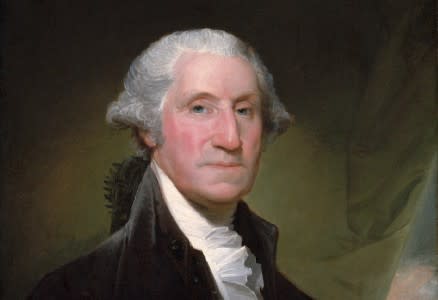Forgotten facts about George Washington’s private life
George Washington is best remembered as a military leader, Constitutional convention delegate and the first President of the United States. But there was a lot more to Washington than a few legends and talk about his teeth.
Pulitzer Prize-winning historian Edward Larson appears at a free National Constitution Center live event on Monday at 12 p.m. talking about his new book, which highlights the often overlooked chapter of Washington’s career between the war and his presidency.
Here are few facts about Washington, the private person, that show more about this multidimensional character who led the Founding Fathers at a crucial time.
1.Washington was the richest president ever
Research from the website Wall Street 24/7 in 2010 listed Washington as the wealthiest president of all time, based on what his assets would be worth today: more than $500 million. Washington had significant land holdings and at least 800 slaves. But he also had some debt problems during his lifetime.
2. So how did Washington acquire his fortune?
Washington was appointed as a surveyor, due to his family connections, at a young age – which gave him the opportunity to buy land. His marriage to Martha Dandridge Custis increased both their fortunes. He also diversified from just planting tobacco on his properties into other lucrative businesses.
3. Washington lost two stepchildren and didn’t have children of his own
Martha Washington, a widow, had two young children from her first marriage, Martha and John. George and Martha married in 1759, but didn’t have children of their own. His stepdaughter died at the age of 16 due to a seizure and his stepson died just after the siege of Yorktown in 1781, where he contracted a disease at the military encampment.
4. His success in business led to his success in politics
As a wealthy landowner, Washington had serious problems with the Stamp Act and other restrictive British trade and commerce policies. Washington eventually joined the Virginia Assembly in 1769 and he chaired a meeting that asked for the First Continental Congress.
5. Washington had to surrender during a battle
Leading a group of troops from Virginia, Washington was forced to surrender at the Battle of Fort Necessity in July 1754 after he made a mistake in positioning the fort. The French let Washington and his troops march away after Washington signed the surrender terms.
6. Washington was a military hero at the age of 22
Washington served bravely at the British defeat at the Fort Duquesne in 1755, although the British forces were routed. Virginia then put Washington in charge of its forces, but the British army wouldn’t grant him a commission. Washington commanded a regiment that finally captured Fort Duquesne in 1758, but he then resigned from the military and went home to Mount Vernon.
7. Did Washington did turn down pleas to become a king?
After the Revolutionary War concluded, a meeting was held in Newburg, New York, where military officers voiced concerns about their back pay and there were grumblings by some that Washington should become a king. Washington diffused the crisis by making a speech that convinces his troops he would get their pay from Congress. But there was never a formal plea from the troops for Washington to become a monarch.
8. Was Washington really a moonshiner?
Washington made a style of whiskey we could consider “moonshine” today, except that he paid taxes and had a license. So we would consider him a distiller, since moonshiners don’t pay taxes. At one time, Washington’s distillery produced 11,000 gallons of whiskey in one year. As president, Washington sent military forces to western Pennsylvania to end the Whiskey Rebellion, when farmers refused to pay excise taxes.
9. And what’s the deal with George growing hemp?
Like other farmers, Washington grew hemp as a cash crop, but it’s not what you think. The hemp wasn’t smoked for pleasure. It was used to make rope, paper, and other products. Washington also grew corn and wheat. He was actually quite an agricultural innovator; he introduced the concept of crop rotation. Washington, the farmer, introduced the mule to America when he bred donkeys from the King of Spain and the Marquis de Lafayette with his own horses. He had 57 mules at Mount Vernon at the time of his death.
10. Technically, Washington didn’t retire after he was president
He came out of retirement in 1798 when war with France was a possibility. President John Adams asked Washington to take command of the nation’s military and put together a force to fight the French. The following fall, Washington retired again to private life after the situation calmed down.
Recent Historic Stories
Forgotten facts about George Washington’s private life
10 fascinating facts about Grover Cleveland, the only double President



